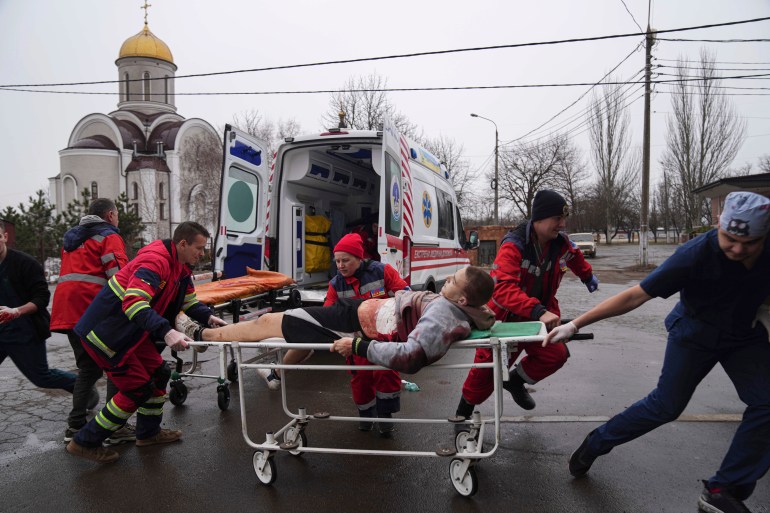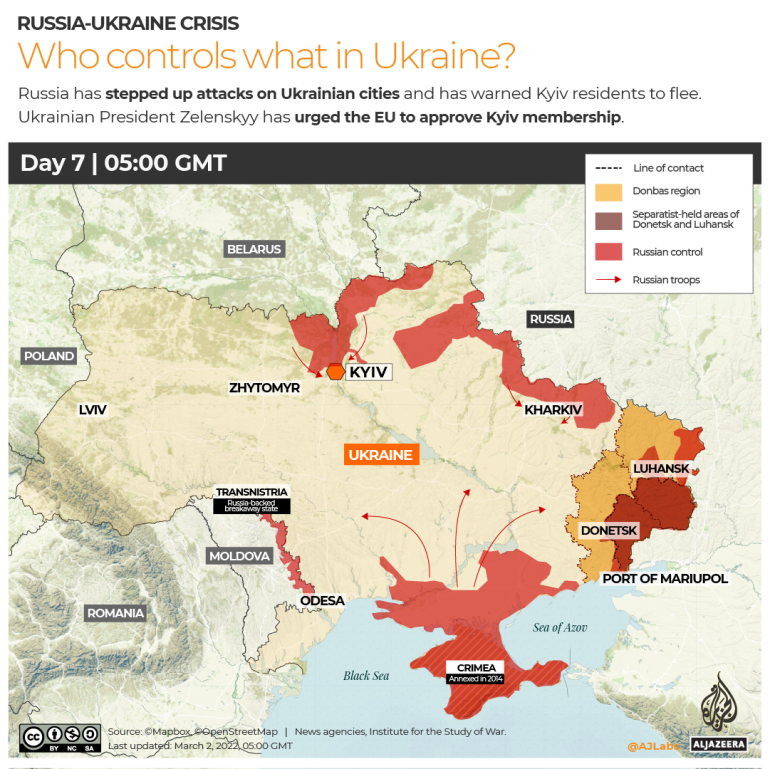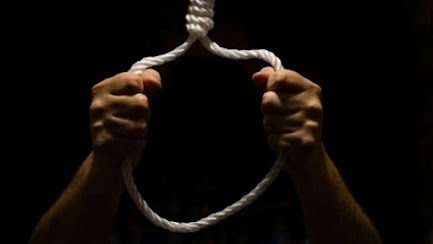Update on Russian-Ukraine War
Update on Russian-Ukraine War
Follow up on Russian-Ukraine War, click here
Overview
After months of posturing while simultaneously denying any plans to attack, Russian President Vladimir Putin’s assaults on multiple cities in Ukraine began overnight on Feb. 24 and have continued day and night since then. A 40-mile convoy is stalled on the highway between Belarus and Ukraine’s capital city, Kyiv.
A senior U.S. official says, “the Russian advance on Kyiv and other Ukrainian cities has stalled amid food and fuel shortages, Ukrainian resistance and slower-than-expected troop movements toward the capital.”
Putin stated that Russian forces were targeting Ukrainian military infrastructure, not people or communities. However, images and stories from Ukraine paint a different picture, including numerous civilian casualties and injuries.
This latest attack is part of a multi-year crisis stemming back to 2014 and beyond.
CNBC reported: “Heightened fears of a military conflict between Russia and Ukraine have been present for some time, and eastern Ukraine has been the location of a proxy war between the two countries. Soon after Russia’s annexation of Crimea from Ukraine in 2014, pro-Russian separatists proclaimed two republics in the eastern part of the country: the Donetsk People’s Republic and the Luhansk People’s Republic — much to the Ukrainian government’s consternation. Since then, there have been ongoing skirmishes and fighting in the region, which is known as the Donbas, between Ukraine’s troops and separatists.”
The Center for Disaster Philanthropy’s (CDP) response to this crisis is focused on humanitarian needs that arise, particularly among internally-displaced peoples (IDPs) and refugees. We are not looking at the conflict itself except in how it affects population movement and humanitarian needs.
According to World Population Review, Ukraine’s current population is 43.3 million people. It states, “Since the 1990s, Ukraine’s population has been declining due to high emigration rates, low birth rates, and high death rates … Many people leave the country because Ukraine is the second-poorest in Europe, is in conflict with Russia to its east, and is beset by corruption. The population is currently declining at a rate of 0.59%, a rate has increased every year since 2015. The United Nations estimates that Ukraine could lose nearly one-fifth of its population by 2050.”
Already people are fleeing the country or leaving areas that have been bombed or at risk of further conflict. On March 1, Kelly Clements, Deputy High Commissioner of the UN Refugee Agency tweeted, “677,000 people have fled #Ukraine to neighboring countries in less than a week. 150,000 in the last 24 hrs.” This is in addition to the hundreds of thousands who have been displaced within the country.
Of the 575,400 who had left by Feb. 28, the vast majority (nearly 340,000) have gone to Poland. Other refugees went to several countries, including: Slovakia (30,000), Hungary (94,000), Romania (34,000), Moldova (40,000) and Russia (129,000). The remainder (34,000) have gone elsewhere in Europe.

Impact
According to the United Nations Office for the Coordination of Humanitarian Affairs (UN OCHA), which is coordinating humanitarian response efforts in Ukraine and deploying additional surge support through Poland, it will take a few days for the full needs to be known. However, UN OCHA issued a summary of humanitarian needs on Feb. 17, which indicated that while 2.9 people were in need, the humanitarian community’s call for support was focused on the 1.8 million people most directly affected by conflict. In eastern Ukraine, seven years of conflict have left shelter, health, protection and water, sanitation and hygiene and other basic needs in an acute emergency phase.
UN OCHA adds: “The effects of COVID-19 continue to create additional pressure on the struggling civilian population and ageing infrastructure – on top of the ongoing hostilities and protracted humanitarian crisis. As a result of COVID-19 restrictions, conflict-weary people have been dealing with severe obstacles to freedom of movement for almost two years. They have been unable to travel more freely across the 427-kilometre-long [265 miles] “contact line” that splits eastern Ukraine into Government- and non-Government-controlled areas (GCA and NGCA), as only two of the five official entry-exit crossing points (EECPs) have been partially operational since March 2020. The majority of current crossing restrictions are applied by the NGCA side. As a result of the partial closure of the “contact line”, in 2021, there has been a 95 per cent reduction in the number of crossings observed compared with the year before the pandemic: from a monthly average of 1.15 million crossings recorded in 2019 (pre-COVID-19) to 59,000 in 2021. Restrictions on movement have left hundreds of thousands of people, particularly the elderly living in NGCA, with limited access to social benefits and entitlements, essential services, as well as have torn them apart from their families and friends. As a consequence of their increased isolation and the abrupt loss of access to services and livelihoods, the severity of needs of those already vulnerable people has increased.”
Critical and Ongoing Needs
Given the current, ongoing and significant escalation and expansion of the conflict, the full set of needs are yet not known. However, the UN has issued a $1.7 billion flash appeal to support humanitarian needs in receiving countries and across Ukraine.
“The UN estimates that 12 million people inside Ukraine will need relief and protection, while more than 4 million Ukrainian refugees may need protection and assistance in neighbouring countries in the coming months … The Flash Appeal asks for $1.1 billion to assist 6 million people inside Ukraine for an initial three months. The programme includes multipurpose cash assistance for the most vulnerable people, food assistance, water and sanitation, support to health care and education services, and shelter assistance to rebuild damaged homes. The plan also aims to deliver support to authorities to maintain and establish transit and reception centres for displaced people and prevent gender-based violence.
Aid groups will need safe and unimpeded access to all conflict-affected areas according to the core humanitarian principles of humanity, neutrality, impartiality and operational independence. With more than half a million refugees having fled Ukraine to neighbouring countries in the past five days alone, and many more expected, support is also required to meet the critical needs of those seeking protection outside the country. The UN High Commissioner for Refugees, Filippo Grandi, said: ‘We are looking at what could become Europe’s largest refugee crisis this century. While we have seen tremendous solidarity and hospitality from neighbouring countries in receiving refugees, including from local communities and private citizens, much more support will be needed to assist and protect new arrivals.’
An inter-agency Regional Refugee Response Plan (RRP) for the Ukraine situation asks for a preliminary $550.6 million to help refugees in Poland, the Republic of Moldova, Hungary, Romania and Slovakia, as well as in other countries in the region in order to help host countries provide shelter, emergency relief items, cash assistance, and mental health and psychosocial support to those who fled Ukraine, including people with specific needs, such as unaccompanied children.”
The 2022 Humanitarian Response Plan for Ukraine launched on Nov. 30, 2021, was already looking for $190 million to protect the most at-risk populations and for the provision of humanitarian aid.
The existing Plan, drafted before the current escalation in the conflict, has three strategic objectives:
- “Provide emergency and time-critical assistance and ensure access to basic essential services for 1.8 million people affected by the conflict.
- Respond to the protection needs and strengthen protection of 1.4 million conflict-affected people, including IDPs.
- Ensure implementation of an international humanitarian exit strategy in GCA from 2021 to 2023.”
The Humanitarian Needs Overview from February 2022 indicates that:
- 252,000 people have educational needs.
- 1.1 million people have food security and livelihoods issues.
- 1.5 million need health supports.
- 2.5 million people require protection.
- 158,000 require support for shelter and non-food items.
- 2.5 million people have ongoing water, sanitation and hygiene concerns.
The scale and urgency of needs will continue to increase. We do know that any family forced from their home needs help with shelter, food, clean water – the absolute basics.
It is also winter in Ukraine, with temperatures regularly below zero. Many families living in the conflict zone already don’t have enough food to eat or clothes to keep warm. With the current escalation, even more will be exposed to the elements and forced to find shelters.

How To Help
The CDP Ukraine Humanitarian Crisis Recovery Fund focuses on addressing humanitarian needs that arise, particularly among the most vulnerable, marginalized and at-risk internally-displaced peoples and refugees. CDP is also in contact with and can grant to Ukrainian and other international organizations that are not 501(c)3 entities.
As with most disasters, cash donations are recommended by disaster experts as they allow for on-the-ground agencies to direct funds to the greatest area of need, support economic recovery and ensure donation management does not detract from disaster recovery needs.
CDP has also created a list of suggestions for foundations to consider related to disaster giving. These include:
- Understand that recovery is possible in protracted and complex crisis settings: Even while focusing on immediate needs, remember that there are early and long-term recovery needs too. We know that people who have been affected by shocks in complex humanitarian contexts can recover and improve their situation without waiting until the crisis is over, which may take years. Recovery is possible and funding will be needed for recovery efforts alongside humanitarian funding. Recovery will take a long time and funding will be needed throughout.
- Recognize there are places and ways that private philanthropy can help that other donors may not: Private funders can support nimble and innovative solutions that leverage or augment the larger humanitarian system response, either filling gaps or modeling change that, once tested and proven, can be taken to scale within the broader humanitarian response structure. Philanthropy can also provide sustainable funding to national and local organizations that support operational costs evolution, independence and other efforts on behalf of affected people.
- All funders are disaster philanthropists: Even if your organization does not work in a particular geographic area or fund immediate relief efforts, you can look for ways to tie disaster funding into your existing mission. If you focus on education, health, children or marginalized populations, disasters present prime opportunities for funding.
- Ask the experts: If you are considering supporting an organization that is positioned to work in an affected area, do some research. CDP and InterAction can provide resources and guidance about organizations working in affected communities.
Contact
CDP has developed a list of organizations responding to the crisis. If you are a responding NGO please send updates on how you are working in this crisis to tanya.gulliver-garcia@disasterphilanthropy.org. Responding donors are also encouraged to contact Tanya to share how they are innovatively assisting people in Ukraine and receiving communities.
If you are a donor looking for recommendations on how to help in this crisis, please email regine.webster@disasterphilanthropy.org for information about our list.
Russia’s army claims Kherson captured
President Zelenskyy says Moscow aims to ‘erase’ Ukraine as Russia’s military claims to have captured key southern city.
Mariupol under heavy shelling, mayor says
Ukraine’s key southeastern port city of Mariupol is under constant shelling from Russian forces, its mayor says.
“We are fighting, we are not ceasing to defend our motherland,” Vadym Boichenko said live on Ukrainian TV.

Russia aims to ‘erase us’, Ukraine’s Zelenskyy says
Zelenskyy has claimed that nearly 6,000 Russians have been killed during the first six days of Moscow’s invasion and warned the Kremlin it will not be able to take control of Ukraine with bombs and air raids.
In a video address, the Ukrainian president said a Russian missile strike in the capital on Tuesday which hit a Holocaust memorial complex “proves that for many people in Russia our Kyiv is absolutely foreign”.
“They don’t know a thing about Kyiv, about our history. But they all have orders to erase our history, erase our country, erase us all,” he added.
Russia has not publically declared how many of its troops have been killed and Al Jazeera was unable to independently verify the figures provided by Zelenskky.
References:



Comments
Post a Comment